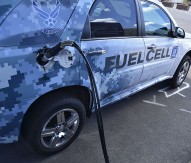
Horizon’s interconnected transport strategy
As one of the six Societal Challenges, building a ‘smart, green and integrated transport network’ is arguably at the heart of the pillar as it will assist in resolving many of the other objectives, notably climate action, energy and health. The sector is also one of Europe’s most valuable, representing 6.3% of the EU’s GDP and employing nearly 13 million people. The industry is therefore a key driver of economic growth and will be instrumental in securing Europe’s long-term economic growth and sustainability. This, however, will only be guaranteed if Europe stays at the cutting-edge of transport R&D.
Taking place in Germany, the 2013 Hannover Messe is a world-leading exhibition of 11 individual trade fairs showcasing the latest technologies from the key sectors of the industrial value chain; these include energy, surface technology, integrated processing and IT solutions, and transport.
Role
Addressing delegates, Máire Geoghegan-Quinn, the European Commissioner for Research, Innovation and Science, outlined the role transport will play in Horizon 2020 and where action will be targeted.
“I want the transport industry to be a leading player in Horizon 2020. [It is] the backbone of an integrated, mobile economy. Horizon 2020 will address transport as an integrated system but it will not ignore the specifics of the different modes of transport, particularly where we need to achieve technological breakthroughs.
“Actions will focus on four areas: resource-efficient transport; better mobility, less congestion, more safety and security (where we expect a cross-over between transport modes); global leadership for the European transport industry; and forward-looking activities to feed into future policy making.”
Not in silo
According to Geoghegan-Quinn, the transport objective will not work separately to the other Societal Challenges, but instead will play a clear role in helping to develop solutions in the other areas of the pillar.
“The transport sector can help mitigate the impact of climate change, reduce environmental pollution, increase resource efficiency, reduce our dependence on oil, improve economic performance and create growth and jobs.
“We will ensure that there are strong links between ‘smart, green and integrated transport and the other challenges, in particular ‘secure, clean and efficient energy’, for example in the development of alternative transport fuels and energy sources and storage, including batteries and fuel cells, and ‘climate action and resource efficiency’, including raw materials, for example on assessing the environmental impacts of transport,” Geoghegan-Quinn said.
“Europe wants to achieve a 60% reduction of CO2 emissions by 2050. Transport accounts for as much as a quarter of current emissions. We also want to halve the use of conventionally fuelled cars in cities and achieve virtually CO2-free city logistics in major urban centres by 2030. We cannot achieve these goals without radical changes in the transport sector – and that is why transport is one of the six main Societal Challenges tackled under Horizon 2020.”
“With the demand for mobility increasing worldwide – the number of cars in the world will almost double by 2030, for example – these priorities respond to a global need for greater sustainability,” the Commissioner stated.
World competitiveness
One of the core goals of Horizon 2020 is too help Europe become more competitive on the global stage and increase the continent’s innovation opportunities. Transport will play its own key role in sustaining both Europe’s economy and environment.
“Investing in innovation in the field of sustainable transport offers European companies a huge commercial opportunity; products and services related to sustainable mobility will represent a global market of €300bn in 2020. We simply cannot afford to let this opportunity slip through our fingers.
The Commissioner continued: “The good news is that Europe already leads in many areas, including high speed rail, efficient trains and intelligent transport systems. But we’re lagging behind our competitors in other crucial areas. Japanese manufacturers are leading the field in hybrid cars and Asia is ahead of us in the development of batteries. It is important that we stay strong in the areas where we are leading and catch up where needed.
“This is why market uptake actions and large scale research and demonstration projects will be an important feature of Horizon 2020. Transport provides an excellent example of the advantages of a challenge based approach where R&D and innovation – in vehicles, infrastructures and operations – all contribute to addressing the challenges facing the transport sector in Europe today. This approach also allows us to reach a number of policy goals in other fields besides transport, including the environment, climate, energy, resources and industrial competitiveness.”
Combining and overcoming the major challenges facing European society, investing in innovation and increasing Europe’s international competitiveness is a combination of goals that Horizon 2020 seeks to tackle. Yet the degree that they will be achieved will only be finally realised in 2020.
Geoghegan-Quinn concluded: “The European transport sector has a lot to live up to. It must become more sustainable, improve its ability to respond effectively to the needs of its users and remain competitive in the face of growing world competition.
“The transport sector in Europe – in all its diversity – has already proved that it is a world-beater and a world leader in research, innovation and technology. Our motor cars are the most sought after in the biggest emerging markets; our passenger aircraft are reshaping the travel industry, and we have shown how high speed rail can shrink distances. The transport industries have a bright future in Europe. Horizon 2020 will be there to support you every step of the way.”
Commissioner Máire Geoghegan-Quinn




